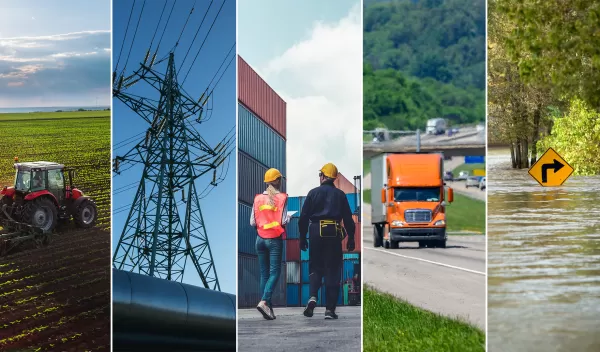
Flood mitigation, rural transportation, supply chains: NSF awards 9 new people-focused research grants
Flood mitigation measures, rural transportation systems and pharmaceutical supply chains are among the subjects being examined by nine new research projects receiving backing from the U.S. National Science Foundation. NSF is investing more than $8 million in the projects through its Strengthening American Infrastructure program. The program supports research that utilizes advances in behavioral and social science to improve the value and usefulness of infrastructure in people's lives, from U.S. roads and highways to state and local power grids.
The projects are centered on social and behavioral science being conducted at institutions across the U.S. in collaboration with researchers from a wide range of other fields, including computer science, engineering, geosciences, mathematics and physical sciences.
"These projects can reveal new ways to enhance safety, reduce pain points in our everyday lives and enable greater prosperity and security for future generations," says Marc Sebrechts, director of NSF's Behavioral and Cognitive Sciences Division. "NSF's Strengthening American Infrastructure program is using the illuminating power of social and behavioral science to examine issues and opportunities at the heart of practically every type of infrastructure that people in the U.S. depend on."
"Strong infrastructure stimulates U.S. job creation, improves our quality of life and protects the well-being of our communities for many years into the future," says NSF Assistant Director for Social, Behavioral and Economic Sciences Kellina Craig-Henderson. "The projects we're supporting are taking science out of the proverbial lab and into a broad new array of areas so communities large and small can directly benefit from their discoveries."
The projects' diverse goals include improving air quality in rural areas with high levels of highway traffic, enabling communities and neighborhoods to retain power during large-scale power outages and helping states and cities effectively plan for increasingly frequent floods and storm surges. In addition to conducting fundamental research, NSF-supported projects will support participation and outreach activities with the residents of several local communities, the creation of new tools and resources that will be freely available to others and multiple educational and training opportunities for STEM students.
The three-year projects will be led by 12 institutions in nine states, including three states within the Established Program to Stimulate Competitive Research which supports areas in the U.S. that have historically received less federal support for research and development:
- A collaboration between Texas A&M University and the University of Michigan will examine the community benefits and risks involved in a proposed new coastal storm barrier designed to protect people in the Houston-Galveston area of Texas from increased storm surges and flooding due to hurricanes.
- Northeastern University researchers will explore how to design a new information infrastructure that can ease the supply-chain disruptions that lead to recurring shortages of medicines and other pharmaceutical products in the U.S.
- Clemson University and the University at Buffalo, State University of New York will collaborate on developing a new cyberinfrastructure system that will provide scientists, cybersecurity professionals and others with a more rigorous way to use artificial intelligence to detect harmful online behaviors such as cyberbullying and inciting violence.
- Purdue University researchers will conduct experiments focused on accurately predicting the long-term community-level impacts of retrofitting older buildings to withstand future earthquakes and other natural disasters. Their study includes buildings such as hospitals and residential complexes.
- University of Virginia and Northeastern University will collaborate on an investigation of how physical infrastructure and social factors affect access to safe drinking water during hurricanes and other natural disasters.
- University of Texas at Austin researchers will investigate how water-utility companies can keep critical water systems operating by more effectively communicating emergency messages to their customers before and during catastrophic events such as winter storms.
- George Mason University researchers will analyze how electrical infrastructure is distributed across the U.S. to understand how the potential costs of supporting an increasing number of electric vehicles can be fairly distributed, particularly for those who do not use electric vehicles and for low and middle-income families.
- University of Vermont researchers will study how investments in rural communities' travel infrastructure, such as roads and bridges, influence people's travel-related decisions and how transportation planners and engineers can most effectively use that information.
- Iowa State University researchers will examine the social and economic benefits of microgrids — small, autonomous electrical grids that deliver power to a local area during natural disasters and other emergencies — for low-income families and other groups who face energy insecurity.
In addition to these nine research projects, NSF is also providing smaller planning grants to other institutions to study the feasibility of future infrastructure-focused research. For additional information, please visit NSF's Strengthening American Infrastructure program webpage.


